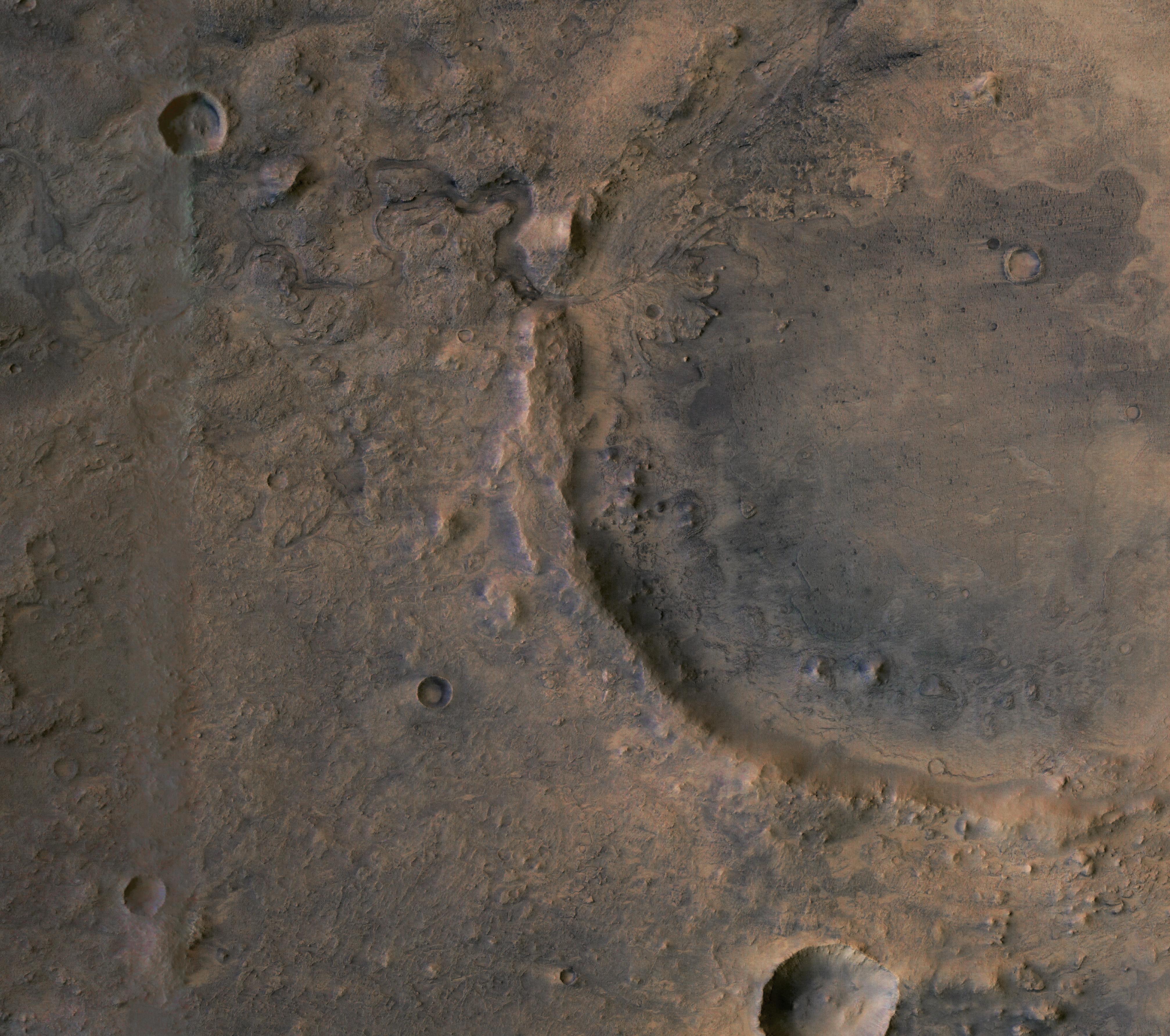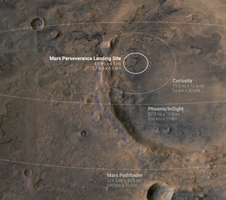
|
Zeroing in on the Target
- Click the image above for a larger view
- Full-Res JPEG (4029 x 3567) (1.8 MB)
- Full-Res TIFF (4029 x 3567) (37.7 MB)
Caption:

Figure 1
The target landing area of NASA's Perseverance rover is overlaid on this image of its landing site on Mars, Jezero Crater (Figure 1). The larger landing ellipses of several other Mars missions are shown for comparison.
As landing technology improves and these landing ellipses shrink, missions can aim for more precise landings, opening up new areas of Mars to explore. Perseverance takes it two steps further than previous missions. First, it uses a new algorithm to time its parachute deployment based on distance to its target rather than vehicle velocity. This shrinks the landing ellipse to 4.8 miles by 4.1 miles (7.7 kilometers by 6.6 kilometers). Second, the rover uses maps stored in its memory to avoid landing hazards within that smaller ellipse during its propulsive descent phase. This allows Perseverance to target safe landing locations within Jezero Crater. The rover is set to land on Feb. 18, 2021.
Improvements in interplanetary navigation tightened the landing ellipse of Mars Pathfinder in comparison with missions before it. It landed by bouncing on the surface with airbags, and has the largest ellipse in this image, measuring 124.3 miles by 43.5 miles (200 by 70 kilometers). The Phoenix and InSight landers used retrorockets to land on three legs, but still had large possible landing areas about 80.8 miles (130 kilometers) long.
In 2012, the Curiosity team developed guided entry technology, shrinking its landing ellipse further. The spacecraft used small rockets to steer itself through the atmosphere as it headed toward Gale Crater.
The basemap image featured here was taken by the High Resolution Stereo Camera aboard the ESA (European Space Agency) Mars Express orbiter. Light color processing has been applied to highlight surface features. The original image can be found here. The European Space Operations Centre in Darmstadt, Germany, operates the ESA mission. The High Resolution Stereo Camera was developed by a group with leadership at the Freie Universität Berlin.
Background Info:
NASA's Jet Propulsion Laboratory in Southern California built and will manage operations of the Mars 2020 Perseverance rover for NASA.
For more information about the mission, go to: https://mars.nasa.gov/mars2020 .
Cataloging Keywords:
| Name | Value | Additional Values |
|---|---|---|
| Target | Mars | |
| System | ||
| Target Type | Planet | |
| Mission | Mars 2020 | InSight, Mars Express, Mars Express (MEX), Mars Pathfinder (MPF), Mars Science Laboratory (MSL), Phoenix |
| Instrument Host | Perseverance | Curiosity Rover, InSight Lander, Mars Express Orbiter, Phoenix Lander |
| Host Type | Rover | Lander, Orbiter |
| Instrument | ||
| Detector | ||
| Extra Keywords | Atmosphere, Crater, Map | |
| Acquisition Date | ||
| Release Date | 2021-01-08 | |
| Date in Caption | 2021-02-18 | |
| Image Credit | ESA/DLR/FU-Berlin/NASA/JPL-Caltech | |
| Source | photojournal.jpl.nasa.gov/catalog/PIA24349 | |
| Identifier | PIA24349 | |
